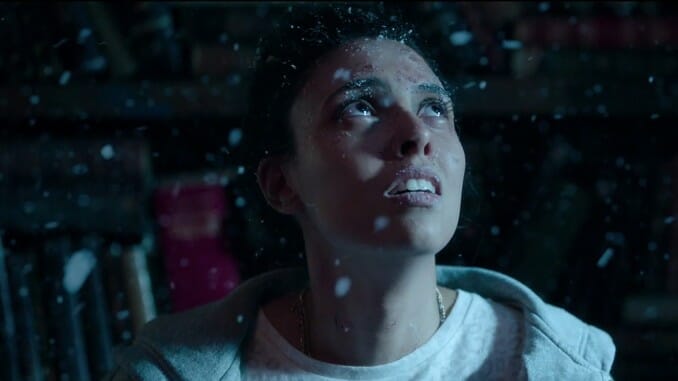Kandisha‘s Tense Creature Feature Brings Moroccan Djinn to Life

Whether she is known as Bloody Mary, La Llorona or Oiwa, the ghostly tale of a woman who suffers cruel betrayal and thus wanders the Earth as a vengeful entity is ubiquitous across most cultures. For their latest feature, French directors Julien Maury and Alexandre Bustillo turn to the myth of Aicha Kandisha—a Moroccan djinn inspired by the real-life 14th century guerilla fighter—who wreaks havoc on a small French city, specifically a group of teenage friends and their families. Despite achieving formidable scares and clever callbacks to the filmmakers’ debut Inside, a sinister specter of clumsy cultural engagement lingers in Kandisha.
Well within the throes of summer vacation, best friends Amélie (Mathilde La Musse), Bintou (Suzy Bemba) and Morjana (Samarcande Saadi) fill their days with impressive street graffiti projects and the occasional fling with local boys. After tagging an abandoned building, Amélie notices the name “Kandisha” spray painted behind some moldy wallpaper. Morjana, whose family is from Morocco, fills her in: “In a nutshell, she’s the ghost of a beautiful woman who destroys men.” After the trio giggle over the incredulousness of the story, they each embark home in the wee hours of the morning with the careful intention of not waking their parents. On her lonely walk, Amélie crosses paths with an abusive ex-boyfriend who knocks her out and attempts to rape her. Miraculously managing to flee, Amélie decides to see if the legend is true. She crudely draws a pentagram in her own blood and chants the name Aicha Kandisha five times. The next morning, her ex is dead—but Kandisha is still not satisfied, taking the opportunity to prey on the fresh French selection of men in the city.
The legend of Aicha Kandisha (sometimes spelled Kandicha) is widely believed in Morocco, perhaps because its origins sprout from a historical foundation. During 14th century Portuguese colonization efforts, Aicha Kandisha was said to be a Moroccan guerilla fighter who strategically seduced enemy troops in order to disarm them and slit their throats. In fact, the name Kandisha is posited to be an Arabic interpretation of the Portuguese word her enemies called her: La Condessa, or The Countess. After the execution of her family and husband by vengeful Portuguese troops, Kandisha fled into the surrounding forest, where she allegedly transformed into a malevolent djinn with camel’s legs and soulless black eyes, forever damned to seduce men to their doom. Though the tale was originally passed down via oration, centuries of retellings and narrative flourishes inevitably and singularly rendered Kandisha into the fearsome woman-monster hybrid associated with her name. Though the nature of her resistance against Western imperialism in her homeland clearly merits keeping her memory alive, the macabre elements of her struggle took over her narrative completely.
It makes perfect sense for a Francophone film to be made about the Kandisha myth, as France has the highest population of Moroccans outside of Morocco due to the history of French colonial rule (and a continued institutional presence) in the North African country. In 2008, Moroccan-French director Jérôme Cohen-Olivar presented his take on the demonic djinn, also titled Kandisha, which follows a renowned French lawyer as she takes the case of a Moroccan woman suspected of killing her husband—in spite of the defendant being steadfast in her belief that the Kandisha is the one responsible for her husband’s untimely demise. The 2008 film’s established setting of Morocco certainly gives further credence to the roots of the myth; meanwhile Maury and Bustillo’s Kandisha brings her reign of terror to France.
-

-

-

-

-

-

-

-

-

-

-

-

-

-

-

-

-

-

-

-

-

-

-

-

-

-

-

-

-

-

-

-

-

-

-

-

-

-

-

-








































